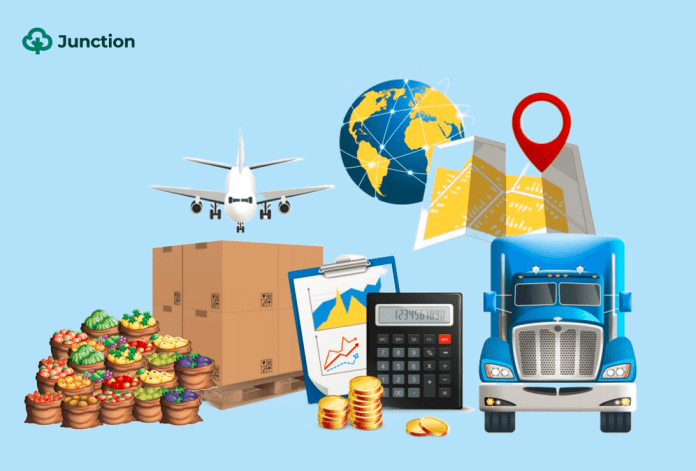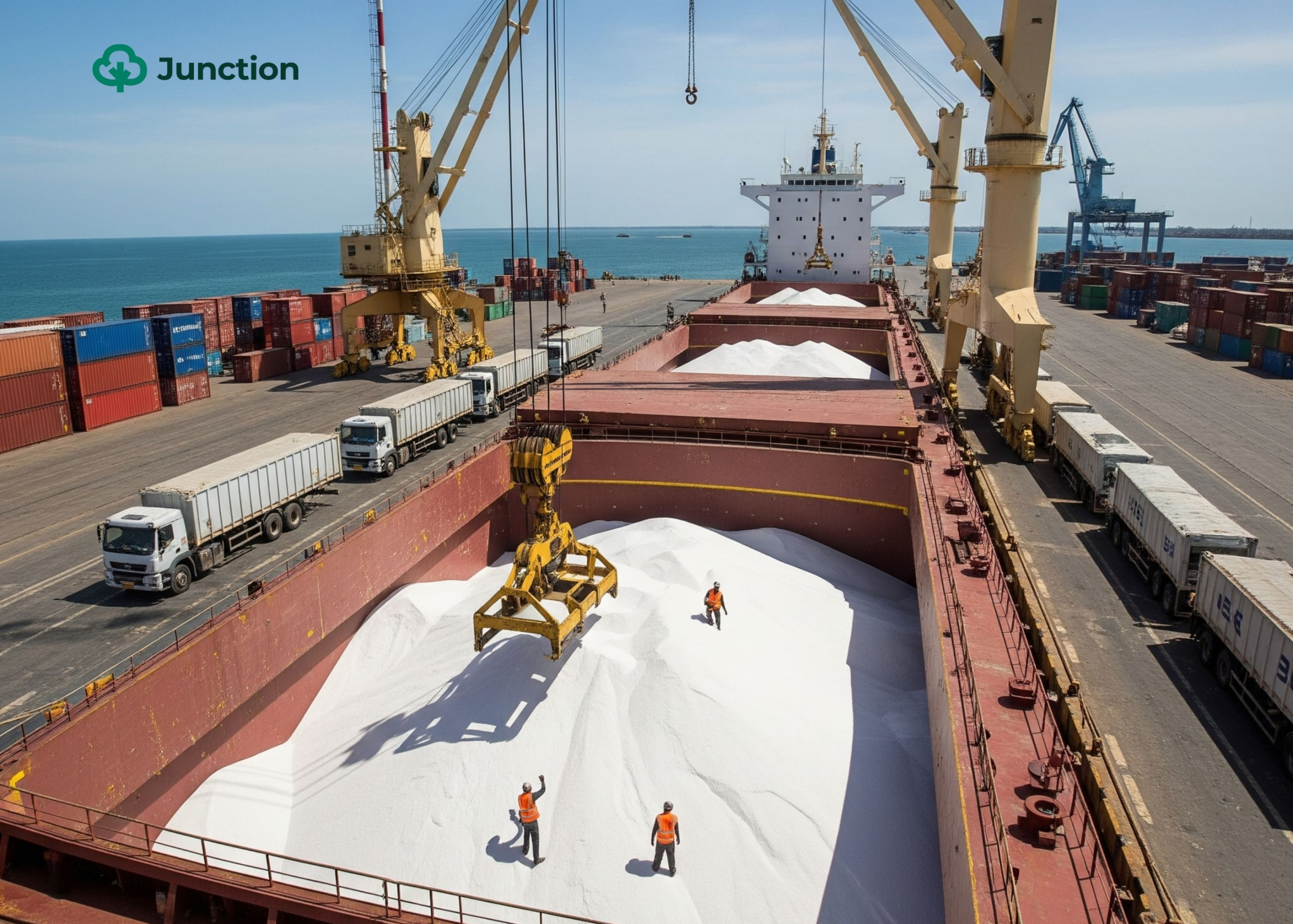Questions answered here: - How rising logistics costs directly impact the growth and productivity of Nigeria agricultural sector? - Why overreliance on one mode of transportation is a problem in Nigeria? - How investments can pave the way for competitive logistics costs?
Nigeriaâs agricultural sector is a major pillar supporting the nationâs economy. As of Q3 2022, agriculture contributed 29.67% to the nationâs GDP. The sectorâs significant contribution stems from its crucial role of providing raw materials and food to both industries and consumers.

However, despite the agricultural sectorâs outsized economic contributions, several issues plague it. Lack of adequate funding, logistics, poor infrastructure such as electricity and road networks, weak institutional support, and a lack of technical expertise are just some of them.
These issues continue to stifle the growth and competitiveness of Nigeriaâs agricultural industry. This is evidenced in the decline in year-on-year growth from 4% in 2016 to 1.9% in 2022.

Of all the challenges faced that Nigeriaâs agricultural sector faces, logistics is a significant problem that it cannot ignore. These logistical challenges have raised concerns over domestic food security, increased costs of agricultural goods, production delays and large post-harvest losses that have ultimately diminished productivity of the agricultural sector.
In this article weâll contextualise logistics and how it continues to undermine agriculture sector productivity in Nigeria.
Letâs dive in.
What are logistics?
Logistics can be viewed as the process by which products or goods from suppliers reach manufacturers or producers and finally end up with consumers in good condition. The best-known instances of this are dispatch riders and Okadas that deliver your online purchases.
Logistics under the context of the agricultural sector refers to the process by which agricultural goods flow continuously and optimally from suppliers (or manufacturers) to producers and then finally to consumers. Several activities are necessary to facilitate this process such as agricultural-production, storage, handling, transport, and distribution.
The activities that facilitate logistics within the agricultural sector must be managed effectively in order to ensure that the maximum value is achieved from the agricultural goods and that the needs of consumers are met in a timely manner. As such, costs attributed with logistics can have a significant impact on the profitability and competitiveness of farmers and agribusiness.
Now that we know what logistics are and how relevant they are to the agriculture sector, next weâll see how logistics costs rising over the years dwindles agriculture sector productivity.
Rising logistics costs are a menace to agricultureâs productivity
Agriculture productivity refers to the ratio of input to output. Meaning, how productive the agriculture sector is depends on the quality and quantity of inputs. Logistics are one of the crucial agriculture sector inputs. This means that rising logistics costs point to an increase in the prices of key agricultural goods like rice and tomatoes.
Nigeriaâs agricultural sector is contains four sub-groups which are: crop production, fishing, forestry, and livestock. Each of these sub-groups have unique challenges and require specific processes in regard to logistics. Unfortunately, the processes including distribution have become challenged as logistics in Nigeria has skyrocketed in recent years amid higher energy costs.
For instance, the price of diesel has tripled from â¦250 per litre in 2021 to over â¦800 per litre today, due to global supply challenges brought about by the Russia-Ukraine war.

Goods are distributed via diesel-run trucks, as such high diesel prices makes it more expensive for farmers and producers to transport agricultural goods around the country.
Insecurity plays a part
Insecurity has also contributed massively to the increase in logistics costs. In recent years, Nigeria has witnessed a substantial increase in banditry and kidnapping along major inter-state road transport highways and networks.
This has not only made it more difficult for farmers and producers but also for transporters and distributors. The attendant impact of this is an increase in logistics costs and prices as the sector players account for the risk of insecurity and high transport costs. For instance, in the first seven months of 2022 there were 2,840 reported incidents of insecurity in Nigeria, with 7,222 people killed and 3,823 people abducted.
Furthermore, post-harvest losses are now recurrent in Nigeriaâs agricultural scene due to inadequate storage and transportation means. Nigeria loses about â¦3.5 trillion annually to post harvest losses, this is equivalent to about 6.7% of the countryâs nominal GDP in Q3 ’22.
Also, the Nigerian Stored Products Research Institute (NSPRI) estimates that post-harvest losses in the country amount to about 50% of Nigeriaâs agricultural production. Certain agricultural products require specialised means of storage and transport such as refrigerated storage facilities and transportation vehicles.
The short supply of these specialised facilities and vehicles in Nigeria have resulted in increased instances of post-harvest losses. Additionally, this has forced farmers and agribusinesses to often rely on expensive and unreliable private storage and transportation solutions that reduce their profits.
Overreliance on road transportation
Moreso, the poor state of infrastructure in the country remains a major reason for high logistics costs in Nigeriaâs agricultural industry. Road transport is the dominant means of transporting goods across the country, the bad state of the countryâs road network especially along interstate routes has made it increasingly difficult to transport goods in a timely manner.
Nonetheless, the unavailability of alternate means of transporting agricultural produce, like railways and waterways, has created a situation with excess demand for transportation while supply is limited. For example, road transport accounts for over 90% of domestic mobility and freight in Nigeria, contributing to increased logistics costs.

Nigeriaâs agricultural logistics lacks modern and advanced technologies to facilitate better post-harvest value chain practices, including logistics. This is evident in the lack of skill and knowledge about modern technologies by most Nigerian farmers.
Additionally, the information constraint within the sector regarding access to ICT facilities and global agricultural supply chain practices by Nigerian farmers limits the competitiveness and profitability of the agricultural sector.
All these issues mentioned above also affect retail vendors of agricultural products. A bus driver interviewed by The Guardian lamented that there is food in rural areas but the cost of transporting it to cities is too high. According to the same driver, it used to cost â¦500 to transport a bag of rice from Lagos to Onitsha in 2015, but this same trip now costs about â¦4,000, pushing many suppliers out of business.
Weâve seen that logistics costs contribute to the rising prices of agriculture sector products. But is this problem specific to Nigeria? These next few paragraphs will answer this question.
Logistics costs are rising globally
In 2020, COVID-19 caused the world to shut down and this had an impact on global agricultural supply chains and logistics networks. Challenges including inadequate availability of supply chain facilities, uncertainty, labour shortage, panic behaviour, and price fluctuations arose as a direct cause of the pandemic.
As countries continually closed their borders to exports and imports of farm produce and commodities the situation became dire. However, farmers and stakeholders across the globe adopted various strategies for the sustenance of the agricultural supply chain and logistics network.
Transport alternatives that work
Technology, skills, information, and already robust/well-built logistics infrastructure contributed to overcoming these challenges. Several countries have honed their agricultural logistics to a point of near perfection in a way that may serve as potential blueprints or guidelines to countries such as Nigeria that are lacking in the area.
Take the United States for instance, which has highly developed logistics networks that span several modes of transportation. The US rail network accounts for a third of all US exports and about 40% of long distance freight volume. The rail industry competes directly with the trucking industry to move goods and products across the country.
Additionally, the US has well developed inland waterway systems that facilitate the movement of large volumes of bulk commodities and farm inputs. The inland waterway system recorded 532.8 million tons of domestic barge traffic in 2017, worth about $220 million. The inland waterway system has saved between $7 billion and $9 billion annually compared to the cost of freight by other transport modes.
The availability of several competing modes of transportation within the USâ agricultural logistics network helps to keep logistics costs affordable for farmers and stakeholders. This contributes positively to the overall productivity and profitability of the US agricultural sector.
Clearly, since covid-19 and more recently the Russia-Ukraine war, logistics costs have climbed across the world, no thanks to rising energy prices. However, as weâve seen so far, Nigeria already had lingering structural issues like poor infrastructure that disrupted the agriculture sector, limited food supply, kept logistics costs high and in turn tapered the productivity of the sector. Next, weâll explore if there’s a way forward for Nigeria.
The road to cooling logistics costs in Nigeria is bumpy
For Nigeriaâs agricultural sector to increase its productivity there must be increased investments and funding for logistics within the industry. These investments should largely target the development of advanced and modern logistics infrastructure.
A good example of this is the newly completed $1.5 billion Lekki deep seaport and its proposed accompanying rail network. The new port is capable of taking vessels four times the size of those in the TinCan and Apapa ports as well as generating $201 billion in revenue.
The port is also expected to create over 169,000 job opportunities both directly and indirectly. The proposed accompanying railway network linked to the port will facilitate efficient and cost-effective movement of goods. The port will be a game changer for the Nigerian logistics and shipping industry and will also result in positive spillover effects for other sectors such as agriculture.
Ultimately, Nigeriaâs logistics industry must become competitive in order for it to truly achieve both efficiency and cost effectiveness. This will necessitate investments into several projects across various modes of transportation including rail and inland waterway systems.
Improving existing infrastructures
Other than investments into new and more modern logistics infrastructure, fixing the current available logistics infrastructure can enable efficiency. Repairing road networks and highways does away with the current cumbersome nature of road haulage and boost overall efficiency and timeliness of the agricultural sector.
Also, improving the countryâs electricity supply would improve storage capabilities for farmers and stakeholders as it would siginificantly diminish the cost of refrigerated storage facilities.
Educating farmers and giving them access to information technology to enable them to gain access to information about the global agricultural supply chain will allow them to remain competitive. This will also facilitate increased instances of value adding logistics services and processes by farmers.
Similarly, the creation of special financial aid or tax exemption packages for farmers and producers will allow them to subsidise their costs and boost their overall productivity and profitability.
Nigeria can also boost its agricultural productivity by ensuring the security of farmers and their farms especially in the most rural of areas that are prone to violence and banditry. Additionally, ensuring security along major highways and inter-state transportation routes will lower the premium that farmers and producers to pay due to danger.
Conclusion
According to a 2019 study by the World Bank, it takes 128 hours on average to export goods from Nigeria. This pales in comparison to the world average of 53 hours and as low as 2 hours in highly efficient countries such as Norway and the US.

Put simply, the Nigerian logistics industry is far from being globally or even domestically competitive. This is severely weighing down the agricultural industryâs productivity as it relies on logistics to get its goods in the hands of manufacturers and consumers.
The impact of this has been high instances of post-harvest losses within the country and increased concerns over domestic food security, implying an increased likelihood of millions of more Nigerians to go hungry. However, by increasing financing and investment into modern logistics infrastructure and upgrading current infrastructure such as roads and electricity among other factors, the country can diminish the current high costs associated with logistics within the agricultural sector and make it cost effective.
This will breathe competitiveness and growth into Nigeriaâs agricultural industry and allow it to achieve new levels of productivity and profitability.



